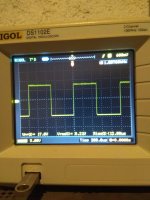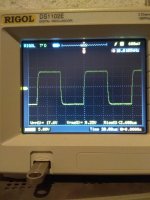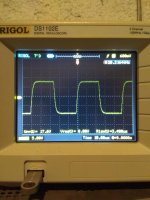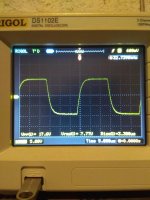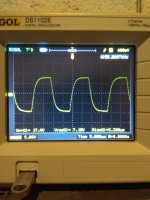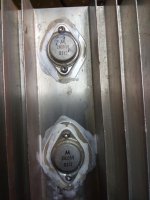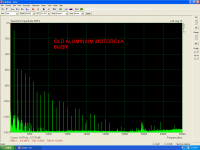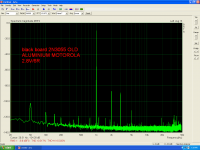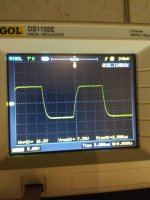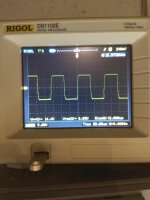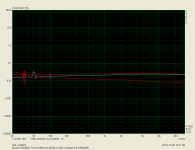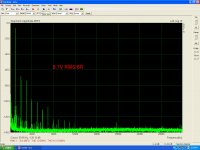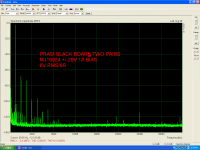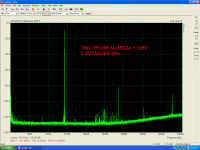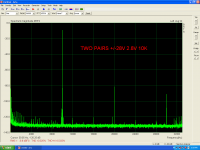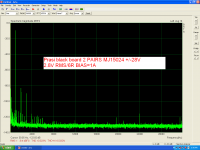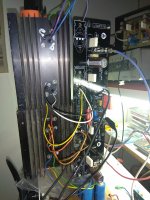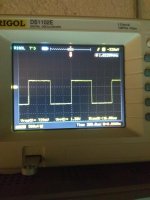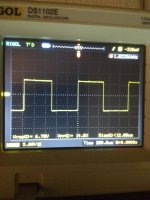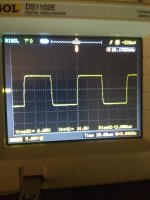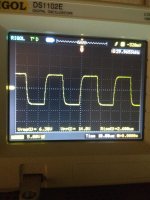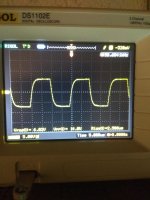Scope test on the red board using TTC5200.
Are you still think that using fast transistors in this circuit is a bad choice?
Personally i can't see any reason.
Please feel free to ask for other test because this still is on the test bed.
Are you still think that using fast transistors in this circuit is a bad choice?
Personally i can't see any reason.
Please feel free to ask for other test because this still is on the test bed.
Attachments
Last edited:
This is a good question. Originally RCA made their 2N3055 which had good second breakdown (1.9A at 60V) but 800kHz fT. When they changed the 2N3055 to epi base the original device was renamed 2N3055H.What is the 2N3055H.
When Motorola produced a 2N3055H they spec'd the same Is/b and fT, though as I suspect it is an epi base device from a process line that has good Is/b and probably an fT around 2MHz. What it actually is I do not know.
But all devices I have measured with 2N3055 label are the high frequency types and perform much better than some seem to think (who may still be thinking of the old slow device).
But I think ON Semi may have recently obsoleted their "H" device anyway.
Last edited:
Unfortunately not.Thimios, do you have any cheapos like TIP3055 or TIP35 on hand?
Sorry!
John. I have come to the conclusion that many transistors are honest fakes. The old TIP 3055 seems to be one. It's not quite the same device as in T03. I speculate that wafers are sold where the company is happy to do that whilst not happy to make up complete devices. MJ15015 is sold as 2N3055 if it fails higher voltage tests.
My Indian 3055's were able to give similar results.
My Indian 3055's were able to give similar results.
Well, there are "me too" devices which you might call "honest fakes" and fakes out there too. When TI developed the TIP3055 they appeared to be cashing in on the 2N3055's reputation with a similar name, but this was an epi-base device from the start. It never was an RCA 2N3055(H). They had a spec. of 70V Vceo which matched the Vcer of the original. But as other manufacturers copied the device the spec changed slightly e.g. some offer TIP3055's with Vceo=60V.
I seem to have been fairly lucky in having found only one or two fakes in the devices I have seen. In one case a power transistor (I can't recall exactly but I think this was a 3055) gave up unexpectedly. Checking the device it turned out to have a small chip, suspiciously looking like someone put too small a device put into TO-3 to make it look like a bigger one.
But the newer (RCA) 3055 (epi) chip (also now obsolete) is smaller than the old (hometaxial). Approx 3.5mm instead of 4.5mm square.
Your Indian 3055's could well be good epi-base devices. I note that at least one well-known manufacturer is producing devices in India. This just reflects the changes as manufacturers consolidate, come and go, and move their production lines around the world.
A good test, apart from the usual run of tests like measuring capacitances and Vbe's etc for Ic which will give a good idea of where the transistor's operating range is, would be a second breakdown test. RCA and Motorola published IS/b test circuits, but I suspect it would now be better done with a MOSFET switch to turn the device off the instant an irregularity is detected. I've never quite got round to that as I've thought that any slight irregularity in the characteristics implies non-ideal behaviour which may still indicate some local damage in the transistor, even if this was stopped early enough not to cause destructive damage. That would apply if measuring the Is/b, but if checking to what is a "known" safe value then maybe would still be worth it where the actual Is/b is not tested for but checked within an acceptable characteristic.
I seem to have been fairly lucky in having found only one or two fakes in the devices I have seen. In one case a power transistor (I can't recall exactly but I think this was a 3055) gave up unexpectedly. Checking the device it turned out to have a small chip, suspiciously looking like someone put too small a device put into TO-3 to make it look like a bigger one.
But the newer (RCA) 3055 (epi) chip (also now obsolete) is smaller than the old (hometaxial). Approx 3.5mm instead of 4.5mm square.
Your Indian 3055's could well be good epi-base devices. I note that at least one well-known manufacturer is producing devices in India. This just reflects the changes as manufacturers consolidate, come and go, and move their production lines around the world.
A good test, apart from the usual run of tests like measuring capacitances and Vbe's etc for Ic which will give a good idea of where the transistor's operating range is, would be a second breakdown test. RCA and Motorola published IS/b test circuits, but I suspect it would now be better done with a MOSFET switch to turn the device off the instant an irregularity is detected. I've never quite got round to that as I've thought that any slight irregularity in the characteristics implies non-ideal behaviour which may still indicate some local damage in the transistor, even if this was stopped early enough not to cause destructive damage. That would apply if measuring the Is/b, but if checking to what is a "known" safe value then maybe would still be worth it where the actual Is/b is not tested for but checked within an acceptable characteristic.
You know I would love some smaller types using T03. That is if they are stated. MJE15034G ( 35 PNP ) comes to mind. If asked to do 2 amps the T03 case would help. If class AB it might be too small, when A it could be OK. High voltage, high( ish ) gain, high ft, cheap. The 35 would suit valve CCS in place of MJE350 ( Morgan Jones ex BBC , highly recomended series of books ).
BD139 is BC639 BD140 is BC640. BD135/6 are voltage fall out BD139/140. I would love to be able to buy BC327-40 337-40 in T0126. The BC327-40 is much like a BC560C with high current ability. The noise is 0.6nV/root Hz. That is close to the 2SA920 or 1085 ( 2SA872A ). Old 2N4401/3 were switching types that often were used for linear circuits due to low Rbb-. BD139/40 are also low noise due to larger base emitter regions. Often people still use the 4401/3 because no one said the BC327/337 could be used. A 327-40 in common base might make a MC preamp with no great complexity whilst great sound.
https://uk.farnell.com/on-semicondu...https:en-GB/Element14_United_Kingdom/w/search
BD139 is BC639 BD140 is BC640. BD135/6 are voltage fall out BD139/140. I would love to be able to buy BC327-40 337-40 in T0126. The BC327-40 is much like a BC560C with high current ability. The noise is 0.6nV/root Hz. That is close to the 2SA920 or 1085 ( 2SA872A ). Old 2N4401/3 were switching types that often were used for linear circuits due to low Rbb-. BD139/40 are also low noise due to larger base emitter regions. Often people still use the 4401/3 because no one said the BC327/337 could be used. A 327-40 in common base might make a MC preamp with no great complexity whilst great sound.
https://uk.farnell.com/on-semicondu...https:en-GB/Element14_United_Kingdom/w/search
Attachments
Last edited:
If there was a choice for my special T03 can is would be silver plated OFC copper. The silver mostly to give a lasting look. Gold would have long term advantages although silver has better initial qualities. Copper is a first class electrical and heat conductor, OFC is worth the extra as it is not expensive. It also is more ideal if soldering AgCu. Alas I guess it will never happen. Most fine copper was near enough OFC since 1930 as it is less likely to snap when being wound. The small conductivity boost is mostly unimportant, it's the fact it does nothing unhelpful. My Indian 3055's are steel. Some in my junk box are non magnetic and could be aluminium.
I played with the idea of cutting a T03 open where the numbers are. Then to oil cool them. I never did get to do it. The problem was to keep things clean to avoid the oil becoming condutive. Water might be better if pure. How long it would remain pure is anyones guess. The other idea was to run a cold water pipe over the can tops without opening the can.
I played with the idea of cutting a T03 open where the numbers are. Then to oil cool them. I never did get to do it. The problem was to keep things clean to avoid the oil becoming condutive. Water might be better if pure. How long it would remain pure is anyones guess. The other idea was to run a cold water pipe over the can tops without opening the can.
OT: PCB connectors
Hi All,
I am playing around with getting PSU etc. on to my JLH board and I am sure that someone mentioned somewhere a source of good quality PCB mount, male solderable blade connectors that are the complement of the auto crimp connectors, - the red blue yellow types.
I have been as far back as I sensible (it was a recent mention) and can't find it - but that might be my dyslexia kicking in.
Does anyone know where to get them. I got some off EvilBay, but they are waffer thin and no good at all.
Thanks and regards from a wet and windy Buckinghamshire
Mike
Hi All,
I am playing around with getting PSU etc. on to my JLH board and I am sure that someone mentioned somewhere a source of good quality PCB mount, male solderable blade connectors that are the complement of the auto crimp connectors, - the red blue yellow types.
I have been as far back as I sensible (it was a recent mention) and can't find it - but that might be my dyslexia kicking in.
Does anyone know where to get them. I got some off EvilBay, but they are waffer thin and no good at all.
Thanks and regards from a wet and windy Buckinghamshire
Mike
One way is to use a terminal pin into this. In some ways better than a PCB type which might not be easy to use. I assume it's a 1/4 inch 6.35 mm type.
https://cpc.farnell.com/amp-te-connectivity/42241-2/terminal-crimp-blade-6-35mm-18/dp/CN17886
Oxfordshire just had the same weather.
https://cpc.farnell.com/amp-te-connectivity/42241-2/terminal-crimp-blade-6-35mm-18/dp/CN17886
Oxfordshire just had the same weather.
DO you mean PCB mount types like this
RS components part # 680 3114
They used to sell gold plated types too and a version with M4 mount holes (which I considered more reliable than solder joints on a PCB), but have not found those yet.
RS components part # 680 3114
They used to sell gold plated types too and a version with M4 mount holes (which I considered more reliable than solder joints on a PCB), but have not found those yet.
Hi All,
I am playing around with getting PSU etc. on to my JLH board and I am sure that someone mentioned somewhere a source of good quality PCB mount, male solderable blade connectors that are the complement of the auto crimp connectors, - the red blue yellow types.
I have been as far back as I sensible (it was a recent mention) and can't find it - but that might be my dyslexia kicking in.
Does anyone know where to get them. I got some off EvilBay, but they are waffer thin and no good at all.
Thanks and regards from a wet and windy Buckinghamshire
Mike
Are you talking about these parts - Faston terminals?
Faston tab part no. 571-1742188-1
Insulated mating part no. 571-33508202
The part numbers are from mouser and fastons are by TE connectivity.
I have used these and These are fantastic.
Regards
Prasi
Last edited:
Hi Prasi
those are exactly what I was thinking of - many thanks.
I have just found them on RS (P/N 680-5911 for anyone else who may want them) and will get them tomorrow so I can carry on with my project.
Cheers
Mike
those are exactly what I was thinking of - many thanks.
I have just found them on RS (P/N 680-5911 for anyone else who may want them) and will get them tomorrow so I can carry on with my project.
Cheers
Mike
Hello Mike,
You are welcome.
These could be slightly better 63824-1 TE Connectivity | TE Connectivity Solder Tab Terminal, Uninsulated, Tin over Copper/Nickel Plated, Straight, 6.35 x 0.83mm | 683-1500 | RS Components
The central bent stubs at the pcb mounting surface (stabilizers as per TE terminology), these should provide additional sturdiness and also help while soldering to make vertical insertion.
You are welcome.
These could be slightly better 63824-1 TE Connectivity | TE Connectivity Solder Tab Terminal, Uninsulated, Tin over Copper/Nickel Plated, Straight, 6.35 x 0.83mm | 683-1500 | RS Components
The central bent stubs at the pcb mounting surface (stabilizers as per TE terminology), these should provide additional sturdiness and also help while soldering to make vertical insertion.
DO you mean PCB mount types like this
RS components part # 680 3114
They used to sell gold plated types too and a version with M4 mount holes (which I considered more reliable than solder joints on a PCB), but have not found those yet.
Hi John,
just noticed your reply.
I currently use M3 screws and ring crimps (also soldered) at the moment and was looking for something a bit more convenient. If using this type of connection, the 'bite' of the connection is obviously the important thing for a good connection. I use crinkle washers to bite into the crimps and pcb tracks, but its getting a bit fidly.
The PCB blades seem to work fine as long as the mating connector is a firm push on - certainly more conveinient. So thanks for the advice guys.
Regards
Mike
Black board two pairs MJ15024
Prasi's black board using MJ15024 .
Power Supply=+/-28v
Bias=1A.
Prasi's black board using MJ15024 .
Power Supply=+/-28v
Bias=1A.
Attachments
Last edited:
Pictures
Attachments
Last edited:
The rest
Attachments
Last edited:
Hello Thimios,
Thanks for testing and posting your findings.
My question is how do all of these sound , that's what must be intriguing to all guys here, as you must have tested more amps than anyone else!
Thanks for testing and posting your findings.
My question is how do all of these sound , that's what must be intriguing to all guys here, as you must have tested more amps than anyone else!
- Home
- Amplifiers
- Solid State
- JLH 10 Watt class A amplifier
